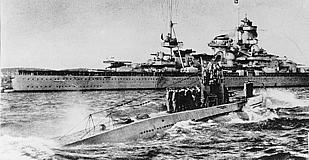U-boat
|
|
- "U-boat" is also a nickname for some diesel locomotives built by GE; see List of GE locomotives

A U-boat ( German: U-Boot) is a German submarine of World War I, World War II or later. The term derives from the German Navy's system of naming its submarines with U- followed by a number, where the U stands for Unterseeboot (literally, "undersea boat"), the German word for submarine. The primary targets of the U-boat campaigns in both world wars were the merchant convoys bringing supplies from the United States and Canada to Europe.
| Contents |
World War I
In May of 1915, U-20 sank the liner RMS Lusitania. Though there was a great deal of outrage at the sinking of an "innocent" merchant ship at the time, historians now believe the Lusitania had 10 tons of weapons aboard, making it a valid target under international law. Of the 1,195 lives lost, 123 were American civilians, including a noted theatrical producer and a member of the prestigious Vanderbilt family. This event turned American public opinion against Germany and was a significant factor in getting the United States involved in the war on the Allied side.
With the United States already on the side of the Allies, Germany announced on 31 January 1917 that its U-boats would engage in unrestricted submarine warfare. See First Battle of the Atlantic.
World War II
During World War II, U-boat warfare was the major component of the Battle of the Atlantic, which lasted the duration of the war. Winston Churchill, the United Kingdom's Prime Minister for most of the war, was quoted as saying, "The only thing that really frightened me during the war was the U-Boat peril." During the early stages of the war, and soon after the United States' entry into the war, the U-boats were extremely effective in destroying allied shipping, coming up to the Atlantic coast of the United States and even the Gulf of Mexico. Advances in convoy tactics, radar, sonar (called Asdic in England), depth charges, the cracking of the German Enigma code, the introduction of the Leigh Light and the range of escort aircraft turned the tide against the U-boats. In the end, the U-boat fleet suffered extremely heavy casualties, losing 743 U-boats and about 30,000 submariners.
Uboat_sinking_survivors.png
During World War II, the Kriegsmarine produced many different types of U-boats as technology evolved.
U-505 was a Type IXC, notable for its capture by the United States Navy in 1944. It is presently a museum ship in Chicago, Illinois at the Museum of Science and Industry. The capture of U-505 was critical due to the capture of her codebooks, which provided the Allies with the ability to read recent German codes.
On 2 November 1942, U-518, under the command of Kapitänleutnant Wissman, attacked two ore carriers at Bell Island, Newfoundland that were shipping iron ore from the island's mines to feed the allied war effort. The attack began at 3:30 a.m. and S.S. Rosecastle and P.L.M 27 were sunk with the loss of 69 lives. However, one of the most dramatic incidents of the attack occurred after the sinkings when the submarine fired a torpedo at the loading pier. Bell Island became the only location in North America to be subject to direct attack by German forces in World War II.
See also
References
- Stern, Robert C. (1999). Battle Beneath the Waves: U-boats at war. Arms and Armor/Sterling Publishing. ISBN 1854092006.
- Movie Das Boot (1981), directed by Wolfgang Petersen
External links
- http://www.uboat.net/
- http://ubootwaffe.net
- The Diary of a U-boat Commander (http://www.gutenberg.net/etext/7947) – Project Gutenberg edition (WWI)
- German U-Boats 1935–1945 (http://www.u-boot-archiv.de) (in German)
- Book excerpt: U-Boat Attack (http://www.third-reich-books.com/x-593-u-boat-attack.htm)
- U-Boat U-35 and Prisoners-of-War, WWII (http://www.U-35.com)
- U-Boat U-434, POWs in Canada (http://www.U-434.com)de:U-Boot
